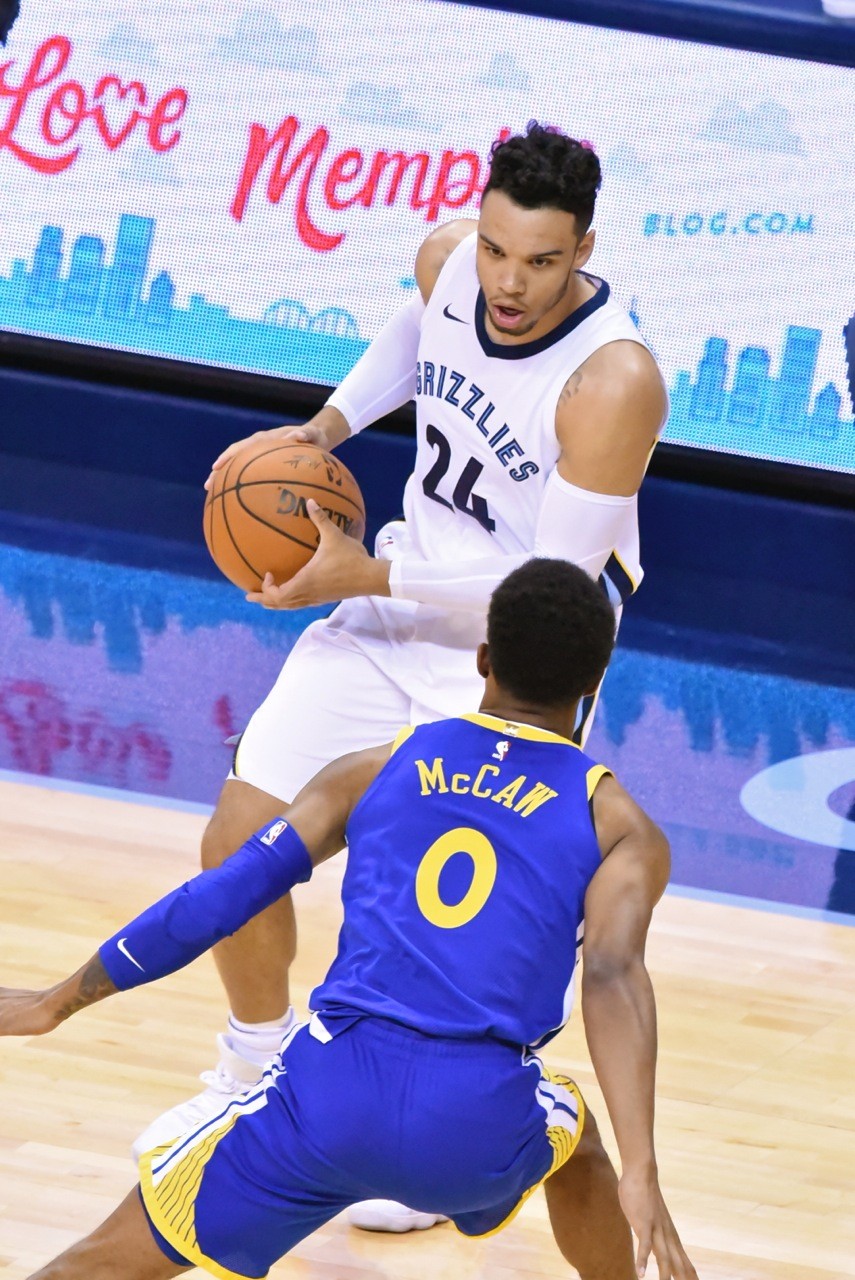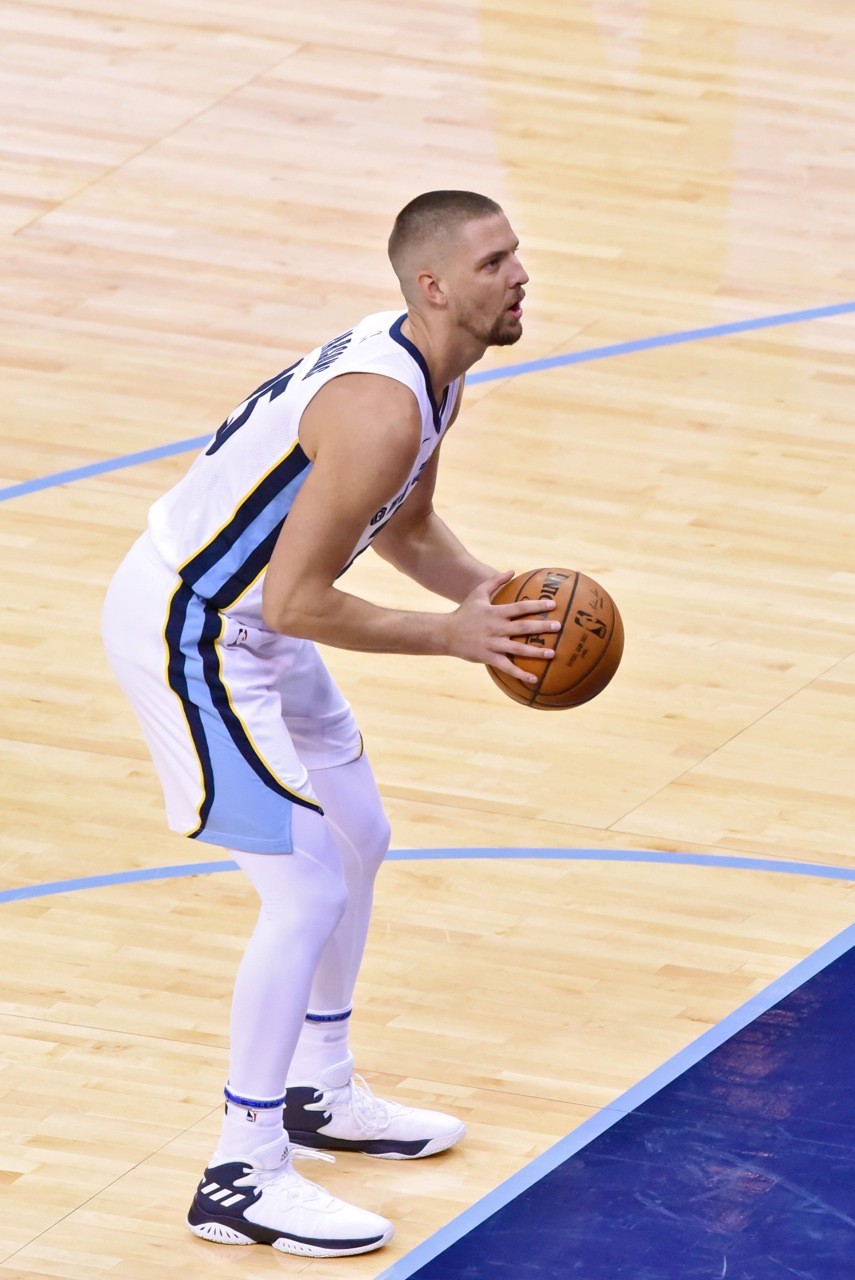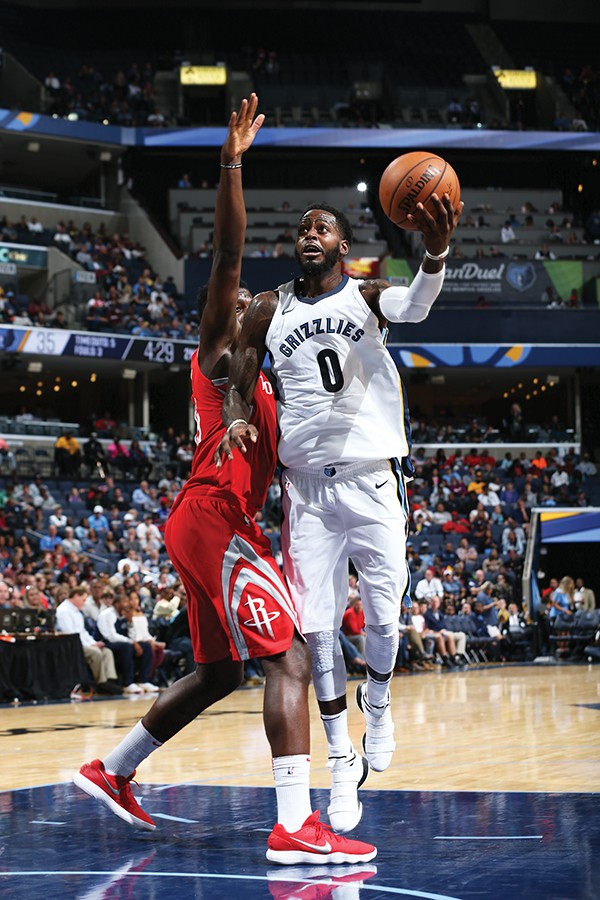Author’s Note: This is my last week at the Flyer, and this is my last piece.

The basic idea was: it was a capital-M Moment, and I thought Herrington was the only one doing it any justice. There were Grizzlies blogs, and I read them, but none of them shared my view, or talked about it the way I wanted to talk about it, and none of them seemed to know how to explore what was happening: in 2011, Memphis burned with the blue flames of the Spurs and Thunder series. It felt like the whole city was boiling over with pride, or with a new energy we hadn’t felt since the 2008 Final Four that apparently never happened.
So I messaged Matt Moore, then only of Hardwood Paroxysm but of a lot of other things in the intervening years, and he pointed me to a little blog called Straight Outta Vancouver, and I sent Tom Lorenzo a sample essay, and, well, if you’re looking for someone to blame for all of… this… there you go.
Why am I talking about this? Easy: like the Grizzlies, I’m in a different spot along my trajectory now. I’m at (or approaching, really) the beginning of a new chapter, and this weird, scrappy basketball team I’ve been covering for a majority of my adult life is in the same place: ready to do something else, unsure how to honor the past and still step into the future, making moves for the next phase.
I. Grit and Grind is Dead
 Larry Kuzniewski
Larry Kuzniewski
Future Memphis Mayor For Life Zach Randolph
Where the Grizzlies have been is not where they’re going.
There’s never going to be another Zach Randolph, in the same way that there’s never going to be another Tyrannosaurus Rex: the conditions that allowed for the past’s fearsome predator to operate no longer exist. And, really, there is no way to have a “Grit and Grind” team without Zach Randolph on it. Tony Allen named it, functioned as its Chaotic Neutral, embodied its space-cadet vibe to the fullest, but without Randolph on the interior infusing the proceedings with an appropriate level of contained violence, none of it happens.
And while “tenacious defense and a refusal to back down” is an easy way to gloss over what the “GNG” years meant, in a very real sense, there was always a level of danger baked into the proceedings. When Z-Bo got tossed for telling Kendrick Perkins “I’ll beat your ass,” he meant it, and was one of maybe five NBA players about whom that was true. Allen never threw hands on the court, but ask OJ Mayo whether TA was willing to get into it.
It seems unlikely that any future incarnation of the team will ever recapture the vibe of the 2010-2015 Grizzlies, in which a collection of the league’s written-offs and misfits came together in the only NBA town that didn’t much care whether they were rough around the edges, because, well, have you seen our edges?
 Larry Kuzniewski
Larry Kuzniewski
Mike Conley, shown here beating the Warriors with a broken face
So, then, it’s important for the Grizzlies, for the people talking about them (especially nationally, where it seems like 75% of the people paid to talk about basketball can’t remember whether they’re still in Vancouver or not), and for the people watching them to remember that the previous era is over. Gone. The truth is, that era ended in the 2015 Warriors series, when they pushed the eventual champs to six games, a blaze of glory, a raging against the dying of the light, etc. That series felt so monumental at the time—that whole playoffs, really—that I thought it would be a good idea to try to write about it like Faulkner. That’s what the first GNG period was.
We also have to come to terms with the fact that the last three years have been a wandering in the wilderness. From 2016’s 28-man rotation, to the first Fizdale year, that flowering of false hope in a different Miami-infused future, to last year’s, let’s face it, outright tank job. (Take that for data.) There’s a clear period of demarcation here, and just because they managed to make the playoffs in two of those three years doesn’t mean there’s continuity. Fleetwood Mac may have kept playing “The Green Manalishi” into the Buckingham/Nicks years, but do you think anybody bought that, either?
No, the door closed on that era in 2015. We know that now. Wherever they go next, no matter how much they keep saying the words “Grit and Grind,” cannot be the same. Experience slips away, just like Geddy said.
 Larry Kuzniewski
Larry Kuzniewski
Tyreke Evans and Tony Allen, in a photo that will never stop looking weird to me
II. Grit and Grind is Permanent
Something changed within the Grizzlies organization between the end of the 2017-18 season and the draft—something bigger than just announcing the hiring “for real” of JB Bickerstaff, last year’s interim coach. What happened was this: The Grizzlies know what a Grizzlies player is now.
For years, we’ve seen this franchise take flyer after flyer on underperforming guys with high upside, guys who were McDonald’s All-Americans in high school and played for Kansas (or some other college program that usually makes the Elite Eight) and hasn’t put it together yet in the NBA. Guys who had bounced around and would be locks for massive contracts if they could only “figure it out.” (Remember those training camps with Hassan Whiteside and Michael Beasley?) That strategy worked when the Grizzlies traded for Zach Randolph, and it worked when they signed Tony Allen for more money than the Celtics wanted to pay him, and it never worked again, not really.
There was another parallel but different strategy at work in the GNG years: adding veterans who could shore up the Grizzlies’ “one piece away” rotation and who wouldn’t make dumb mistakes, guys who played hard on minimum deals and could pull you through a bad Thursday night in Milwaukee if the team needed them to. Sometimes, of course, they got to Milwaukee, got ejected, and then chased John Henson into the tunnel, but that seems beside the point.
What there wasn’t, in all of these years, was a concept, or a Platonic form, of a Grizzlies player. The MO of the front office seemed to be to repeat the process that led to the construction of the Zach/Tony/Mike/Marc/(Rudy and then Tayshaun) core, when that process was never a repeatable or reliable one to begin with. Garbage in, garbage out, and eventually that methodology nets the second-worst record in the entire danged Association.
Once Bickerstaff had the reins, one started to hear an alarming number of references to “bringing back Grit and Grind,” references which raised the hackles of this Griz-Watcher more than once. What do they mean by that? Are they going to sell a pick to the Mavericks and sign Jeremy Pargo again? But now, of course, with the passing of the last few weeks, we know what they meant.
 Larry Kuzniewski
Larry Kuzniewski
Dillon Brooks
They Grizzlies have identified The Form Of A Grizzlies Player: excellent defender, high basketball IQ, big for his position (something that has always factored into their player evaluation—lookin’ at you, Andrew Harrison), not a star but generally acknowledged to be good. Jaren Jackson, Jr. fits this bill. Kyle Anderson fits this bill (except maybe the size thing, but he’s not undersized). Omri Casspi fits this bill, even—he’s 20th among small forwards in Defensive RPM.
I’m sure there are other attributes they consider, but a prototype is emerging, and it’s important, because: that’s what it really means to have an organizational culture. Grit and Grind, whatever it was back in the dead past, was a culture, sure, but it was a player culture. It came from the guys on the team, and how the gelled, and what they were like. It probably also came from having a hardboiled, grizzled Lionel Hollins calling the plays. That’s great, and it certainly lead the Grizzlies to their greatest successes as an NBA franchise, but the problem with a player culture is exactly what we’ve seen in the Griz since 2016: when those players are declining and/or gone, the culture isn’t sustainable.
Grit and Grind is permanent because in its new organizational form—which is necessarily different from its previous player-based form—it’s a sustainable model for player evaluation and basketball system decisions.
III. Grit and Grind Exists Outside of Time
OK, so what does that mean for next year? When are the Grizzlies going to be good again?
The bad news for Grizzlies fans is that a “new Grit and Grind” doesn’t answer either one of those questions, and can’t, and here’s why: the moves the Grizzlies are making, and the philosophy they’re putting in place, is intended to give them a path forward from the Conley/Gasol era, but they’re still in the Conley/Gasol era.
Gasol has two years left on his max deal (one if he decides to opt out after this season). Chandler Parsons has two years left on his max deal. Mike Conley has three years left on his max deal. The plan, at the time of the Parsons signing, was to build the Grizzlies’ next four years around that trio, and thus shift philosophies while maintaining their streak of success for the length of Gasol and Conley’s contracts.
 Larry Kuzniewski
Larry Kuzniewski
Chandler ‘Knees’ Parsons
We’ve seen—not least of all in Parsons’ nearly continuous knee injuries—how well that plan has gone. Because of the myriad ways in which the Grizzlies’ Summer 2016 plan for The Next Core has gone pear-shaped, they’re now in a position where their only option (given the two first round picks traded back when the first plan was coming together: the 2017 first traded to dump Marreese Speights’ salary and the 2019 protected first traded to bring in Jeff Green, the latter of which still makes me want to vomit) is to work with what they’ve got.
What might “working with what they’ve got” look like in 2018-19 and beyond? If Mike Conley returns from injury looking anything like he did in the single full season under David Fizdale, and if Chandler Parsons can contribute more than he did last year and play in more games, and if Marc Gasol’s foot holds together another couple seasons and the drop-off in his play last season was because of the bad team and the poor motivation and not because he’s 33 this summer and starting to decline because he’s played pro basketball since leaving high school…
…they might make the playoffs. They’ve certainly shored up the rotation. But given that Conley has missed large portions of two of the last three seasons, and that Parsons has done the same and moves like a 29-year-old trapped in a 37-year-old’s body, and that there’s no way to know what Gasol might look like until we get into the season and see, that’s a bet I’m not sure I’d take.
If they were healthy all season last year, the Grizzlies probably would’ve made the 7 or 8 seed. That much seems clear. But no team in the NBA is healthy all season, not even the Warriors, and a team that can’t survive a single injury to any of its best players is not a team that can be counted on to do much of anything.
And here’s what I think: it actually doesn’t matter much whether the Grizzlies make the playoffs next year; what’s much more important is that they win enough games to escape the protections on the pick owed to Boston. If the Grizzlies finish outside of the top 8 of the 2019 draft, their first round pick goes to Boston. If they’re bad enough to be in the top 8, they keep the pick and then their 2020 pick goes to Boston if it’s outside the top 6. If, for some reason, the Grizzlies are so bad in 2018-19 and 2019-20 that their pick doesn’t convey to Boston, their 2021 first round pick goes to the Celtics completely unprotected.
 Larry Kuzniewski
Larry Kuzniewski
Jeff Green, in happier times
This is why you (1) never trade a first round pick five years in the future, because you don’t know what your team will look like then, and (2) especially never trade any pick that could potentially become an unprotected first for Jeff Green. You shouldn’t trade a Tops cheeseburger for Jeff Green. You shouldn’t trade a nice, well-used Snapper lawnmower for Jeff Green. I hated trading that pick at the time and I continue to hate it, and I hope the summer of 2019 is the last time I have to get worked up about it.
But what does that mean? It means the Grizzlies really need to win enough games to finish, by my reckoning, 9th or so in the Western Conference, so they can give a back-end lottery pick to Boston and move on with their future. If they can’t make it to 40 wins, or 38, or whatever that means, they’re going to need to try to move Conley, Gasol, or Parsons (LOL) and press an even bigger reset button. They have good young talent around, and if they’re going to be bad anyway, they might as well try to recoup that missing draft pick somewhere along the way.
And while they’re doing whatever they’re doing, there’s old Grit and Grind. The next two years could be great—it’s plausible if not likely that they could, say, be the 8 seed one of the next two seasons. But they could also be a storm to be weathered, with the “tear down the old core” portion of the rebuild happening after the “bring in young talent” portion has already happened. That’s a good thing, really: in Jackson, Anderson, Dillon Brooks, and maybe Andrew Harrison, they’ve got some very good young pieces around which they can build already on the roster. That’s not how rebuilds usually go.
But Grit and Grind, in its new top-down form, suffusing the whole organization with its endless determination Not To Bluff and to be Vs. Errbody and whatever else, will still be there, still be evaluating players, still be creating a system and a style of play from the ashes of long ago playoff successes (and failures, because let us not forget that what made the Grizzlies vulnerable was ultimately their inability to cope with the new “Pace & Space” NBA that sprouted some time around 2012-13).
It’ll still try, in its new and grasping way, to be a basketball culture that reflects something of the identity of its host city: an underdog mentality bordering on a complex; a flat refusal to go along with what’s happening in the more glamorous places, whether that’s Nashville and Austin or Golden State and Houston; a collective of weird people doing weird things in the night, whether that’s Lawler and Kaufman at the Coliseum, or whatever studio allowed Mystic Stylez to be recorded on its equipment, or FedExForum when Zach Randolph gets ejected from a playoff game.
Grit and Grind is gone, and it will never go away.
 Joe Murphy (NBAE/Getty Images)
Joe Murphy (NBAE/Getty Images)  Joe Murphy (NBAE/Getty Images)
Joe Murphy (NBAE/Getty Images)  Joe Murphy (NBAE/Getty Images)
Joe Murphy (NBAE/Getty Images)  Joe Murphy (NBAE/Getty Images)
Joe Murphy (NBAE/Getty Images) 
 Greg Cravens
Greg Cravens 